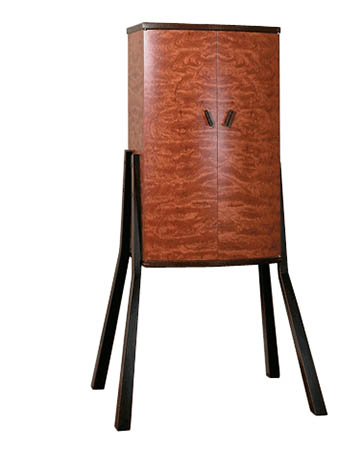
Although Michael Gloor describes himself as self-taught in woodworking, he does have a BFA in clay – “I kind of brought my aesthetic in clay working and started building furniture, and that’s where I am.”
“For me,” he explained, “it’s kind of about the volume of the piece and the shapes and the line and keeping those fairly simple and then letting the wood do all the talking.”
As part of letting the wood do the talking, he generally sticks to clear staining, adding accents through the figures and colors available in veneers. “There’s such a palette of woods avaialable,” he said. “Mahogany was my favorite for a long time, but now it’s hard to source it, so I lean more toward cherry these days, and some of the exotics. Wenge is a favorite. It’s easier for me to say the ones I don’t like, which are basically I’m not crazy about oak and I’m not crazy about black walnut – but I’ll work with anything.”
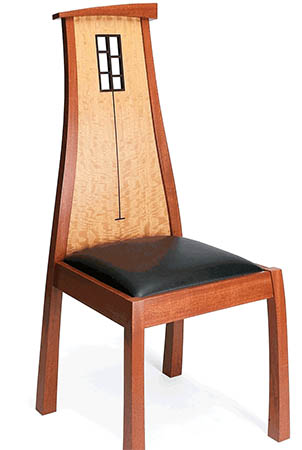
In his work, Michael said, “I suppose you could say there’s a little bit of Art Deco, because I like to work with really showy veneers. “ He also cites historic Japanese architecture, such as the curves and lines of temples; the simplicity of the Shaker style and the clean lines of Scandinavian furniture as influences. “I keep it simple; I don’t get into a lot of detail work as far as moldings or carvings and whatnot.”
“What I do like is designing something where I’m not sure exactly how I’m going to make it. That process of figuring out the technique and the construction method is part of the challenge and part of the fun.”
A recent piece, for example, is a sideboard selected to be in the New Hampshire Furniture Masters catalog (Michael is a 2017 invited artist). “The top was three pieces, but it’s three pieces joined together in non-constant arcs that basically I laid out by fair curving with a stick and then joined them up. So it was a large, complex joint, and that’s just kind of fun to figure out how to do that and do it well.”
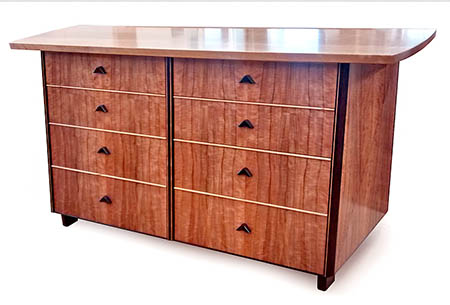
“The fair curve stick comes from boat building: you take a long, thin stick and you bend it and you try to get it to hit certain points, and then it fairs itself between those points, so you get these nice fair curves. And then you make a pattern for that, and that becomes the pattern for the curve, so you get these nice fair curves. You’re not striking an arc using a big trammel or something like that,” Michael explained.
He has some familiarity with boat building techniques because, after graduating from the Kansas City Art Institute, he needed a job and fell into woodworking, first as a laborer on a construction crew, then doing some finish carpentry, boat building and stair work.
Another design challenge with a pleasing result, Michael said, was a china cabinet that came about because he wanted to design a china cabinet which looked like the shelves were floating; they appear to project through the cabinet.
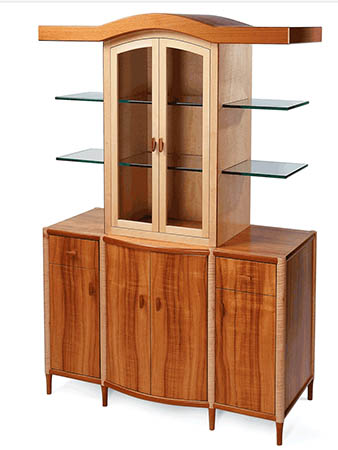
And, for his “Walking Man” series of cabinets, he has done three different iterations. “The original idea was to have a CD cabinet, back when CDs were around, and I wanted a cabinet that looked like it was going to walk away.” Two of these were commissioned pieces, including the first, a small one with long legs. The second, Michael said, “was much more formal. I call it the pinstripe version. That was actually a liquor cabinet for a customer. The third one, I call it the Betty Boop version because I used the natural edge of the veneer when I book-matched it on the doors and then offset handles, and to me, it kind of looked like the old cartoon character, with the eyes and whatnot.”
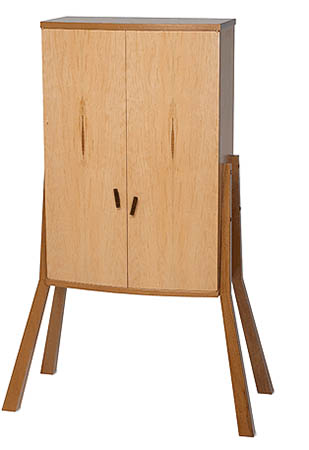
Recently, Michael is moving toward more woodturning work, as well. Years ago, some friends had showed him a few spindle turning techniques for making feet and handles for his furniture, but it wasn’t until he took a workshop with David Ellsworth about seven years ago that he started bowl turning. “It’s not something I do full-time; I’ll kind of go in binges where I’ll turn for a while and then I won’t touch it for a while.”
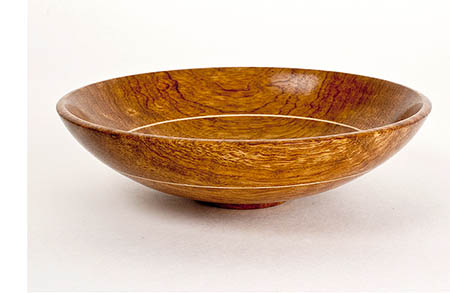
It does, however, appeal to him in its similarities to his original love of clay work. “While the process is different, in that clay is an additive process and turning is a reductive one, other than that, the forms are basically the same.” It also appeals to a sense of near-instant gratification. “One of my realizations about furniture versus clay work is that I think clay really suits my personality better because I tend to be kind of impulsive,” Michael said. “Furniture, you really have to think it through and plan the piece because there’s a lot of labor and time involved.
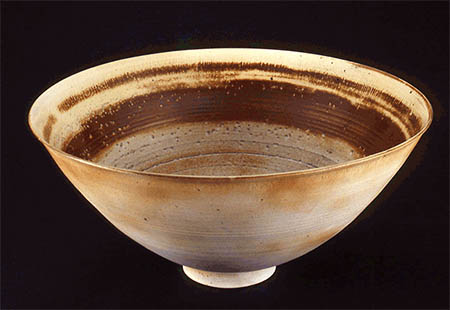
“Whereas with clay, you can throw a bowl, say, and you don’t like it, you just put it back in the slop bucket and start over. It’s no real loss, whereas with furniture, you’ve kind of spent a lot of time and materials for something that didn’t quite work. I think that’s probably why turning is appealing to me more, because it is more immediate: within an hour or so, you’ve got something, or you don’t.”





